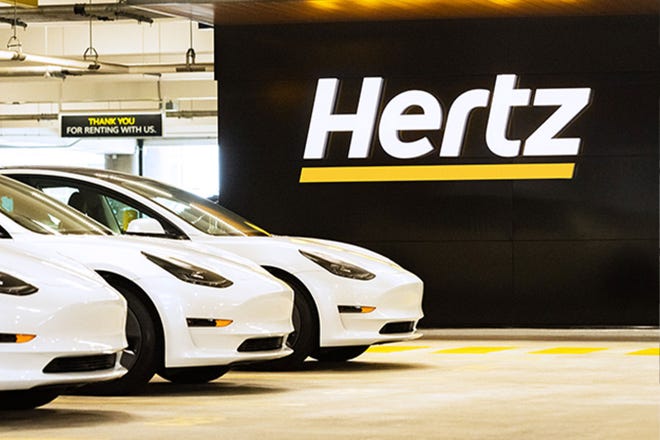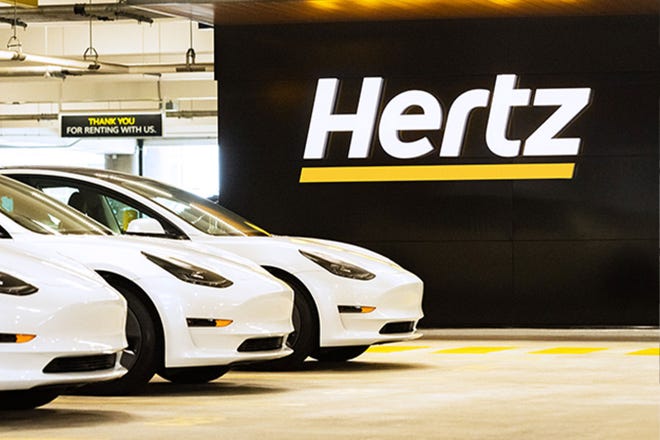
Hertz plans to add more choices to its line-up of electric cars.
In an earnings webcast Thursday, the Estero-based rental car company’s executives mentioned plans to expand and diversify the battery-powered options, beyond Teslas and Polestars.
Executives confirmed talks are underway with other car manufacturers, without giving up any names.
As the first rental car company to invest heavily in electric vehicles, Hertz is looking to build on its early successes, which contributed to a strong second-quarter performance that beat Wall Street’s expectations.
Previously:Hertz offers more settlements to rental customers claiming false car theft arrests
And:Reba McEntire’s new tour is heading to Hertz Arena
The company now has about 20,000 Teslas for rent, and it’s not stopping there.
Meanwhile, Polestars started joining Hertz’s fleet in June.
In a phone interview following the webcast, Kenny Cheung, the company’s CFO, said enthusiastically: “We want to electrify the world.”
Deals with other electric vehicle manufacturers, he said, could be struck in the coming months.
For Hertz, the investments are both a financial and social decision, as part of the company’s sustainability plan.
“We won’t change our logo or anything,” Cheung said. “But we are going green.”

The decision to go green is generating higher rental revenues and greater customer satisfaction — and loyalty.
Uber drivers, for one, are paying more to rent Teslas from Hertz, seeing it as a way to differentiate themselves and earn more money, saving on gas and collecting a $1 bonus per ride.
The company reported that more than 15,000 Uber drivers have rented a Tesla from Hertz to date, at a minimum rate of $334 per week.
Meanwhile, Hertz’s traditional customers on- and off-airport are paying $30 to $35 more to rent a Tesla.
“We are a first mover here and it is really paying dividends,” Cheung said.

Overall, the company is seeing a lot of momentum in its business, with strong demand for its products and services, he said, and no signs of a slowdown.
As a result, Hertz had a strong second quarter.
Stephen Scherr, Hertz’s CEO, summed up the performance as impressive in a company statement.
The results set a few quarterly records.
Those records included:
- Generating $764 million in adjusted corporate EBITDA (earnings before interest, taxes, depreciation and amortization)
- Producing $484 million in adjusted free cash flow
The company recorded revenue of $2.3 billion, up 25% from a year ago — and up 30% from the first quarter.
Net income — or earnings — increased to $940 million, or $1.13 a share. Last year, it ended up in the negative.
Adjusted for one-time costs and gains, earnings came in at $520 million, or $1.22 per share. That’s a 27% increase over last year — and beat a Zacks Consensus Estimate of $1.13 per share.
The second-quarter results not only reflect positive market forces and high demand for rental cars, but the strength of Hertz’s operations and strategic decisions, with a laser focus on its return on assets, Scherr said.
The new Hertz that emerged from Chapter 11 bankruptcy operates differently from the old one in more ways than one.
Besides its decision to invest in electric cars, today’s Hertz is fleeting up and down to meet demand, to try to ensure it doesn’t get caught with too many vehicles — unlike in the past.

“By sweating our assets, we are making careful decisions regarding additions to the fleet and equally prudent decisions about the volume and manner by which we dispose of vehicles. And we will continue to do so,” Scherr said.
By year-end, the fleet size is expected to be about the same as it was at the beginning of the year.
The company is benefitting from higher prices for used cars and its new sales partnership with Carvana, which is bringing a premium over wholesale prices.
Unlike hotel rooms or airplanes, cars are agile assets that can be bought and sold quickly to match demand, Cheung pointed out.
“Once you overfleet, it’s a race to the bottom,” he said.
Reflecting the high demand for travel, Hertz reported that revenue per unit, or vehicle, hit a June record of $1,667.
With travel remaining strong through July — and expected to stay elevated through the summer, the third quarter is looking bright for Hertz, Cheung said.
With that strong demand, pricing is still higher than usual, amid the tight supplies of new cars in general, which continues to boost revenues for Hertz.

The third quarter is usually even busier than the second quarter for the company.
“Travel trends relating to the recovery from COVID are prevailing over the risks of an economic downturn. Until that equation changes, we will continue to benefit from the former and we’ll be ready for the latter,” Scherr said in the webcast.
While leisure — or vacation — trips have been driving the rebound in travel, Hertz has started to see an increase in customers traveling for business, as well as more demand from international travelers as COVID-related restrictions have eased, Cheung said.
Hertz continues to freshen its fleet and to invest in its technology and talent. The company now has about 20,000 employees globally, compared to about 40,000 before the COVID-19 pandemic hit.
“We are doing more with less,” Cheung said.
The company has been buying back stock, in keeping with its promises to return more capital to the investors who’ve stood by it.
In the second quarter, it completed a $2 billion buyback, purchasing 97.8 million shares.
Under a second plan — valued at the same amount — it has repurchased about 9.3 million shares, with $1.8 billion remaining.
Looking ahead, Scherr said: “I am increasingly confident in our ability to execute on our core business plan and excited by our strategic initiatives, which position Hertz for success in an evolving mobility ecosystem.”
Shares closed higher Thursday on the positive news, settling at $20.16, up $2.74, or nearly 16%.

